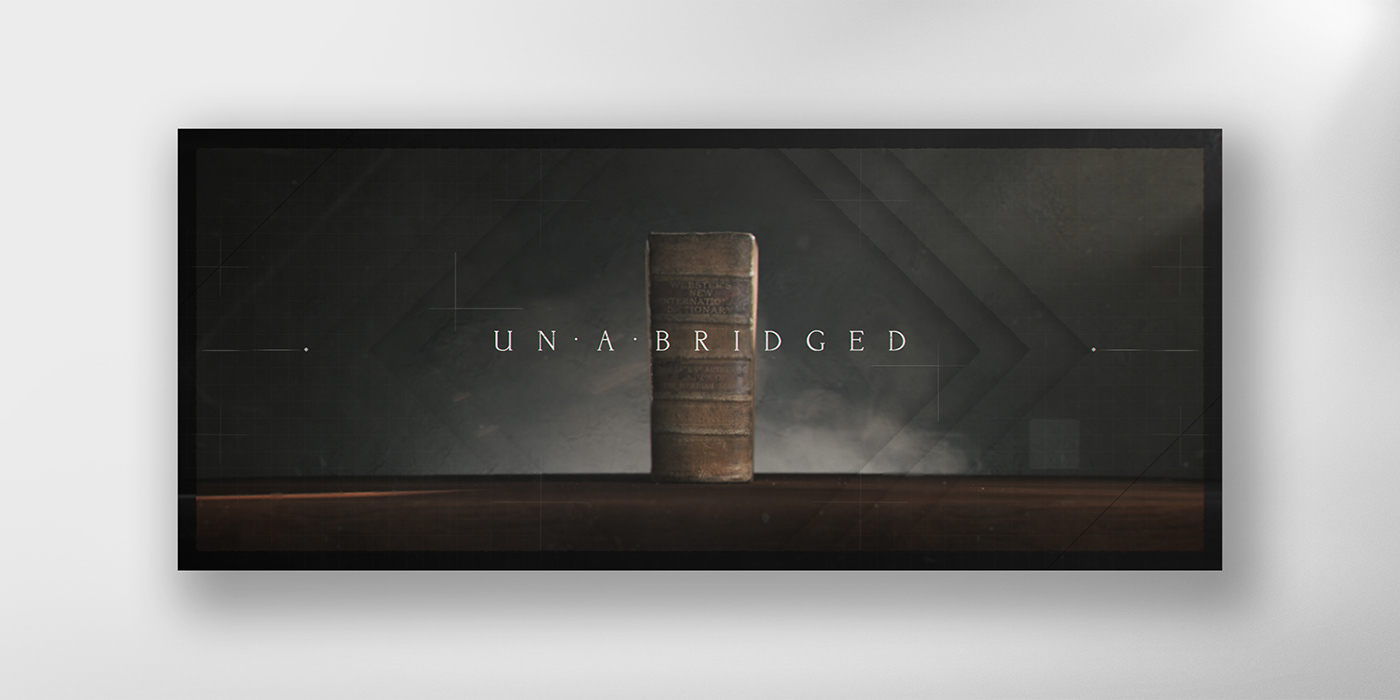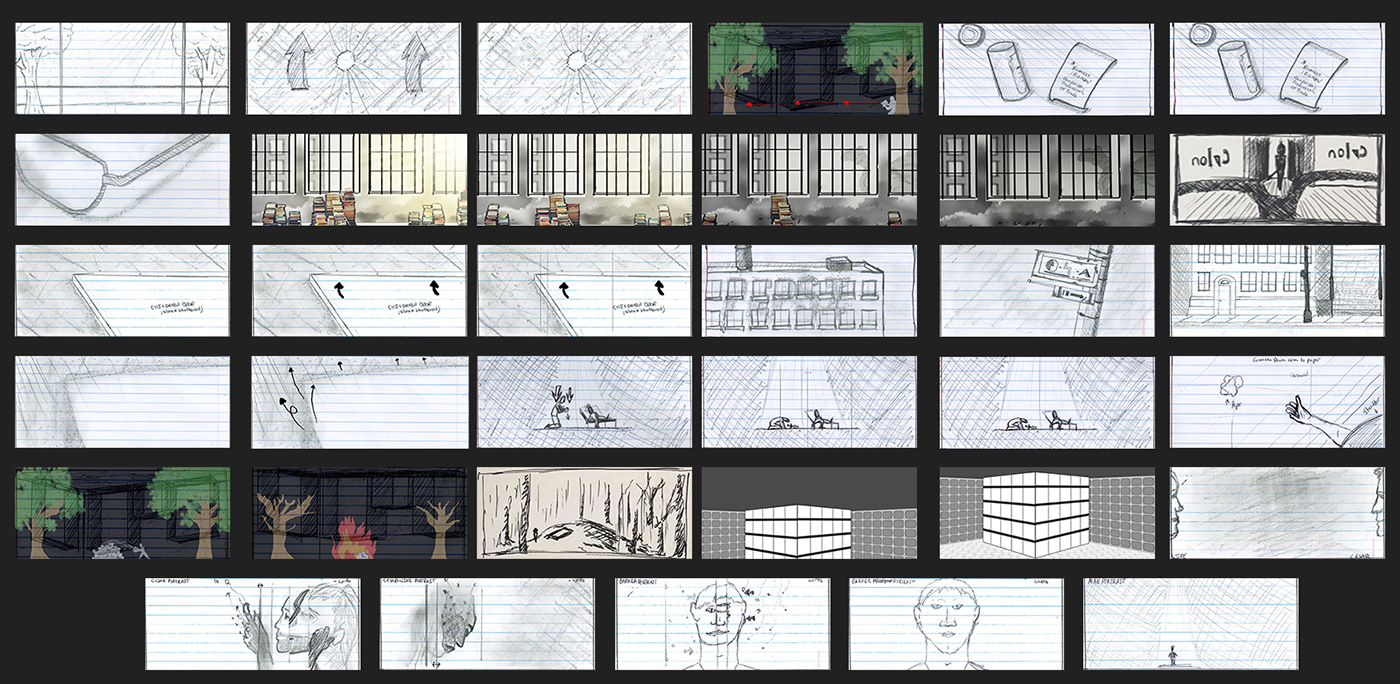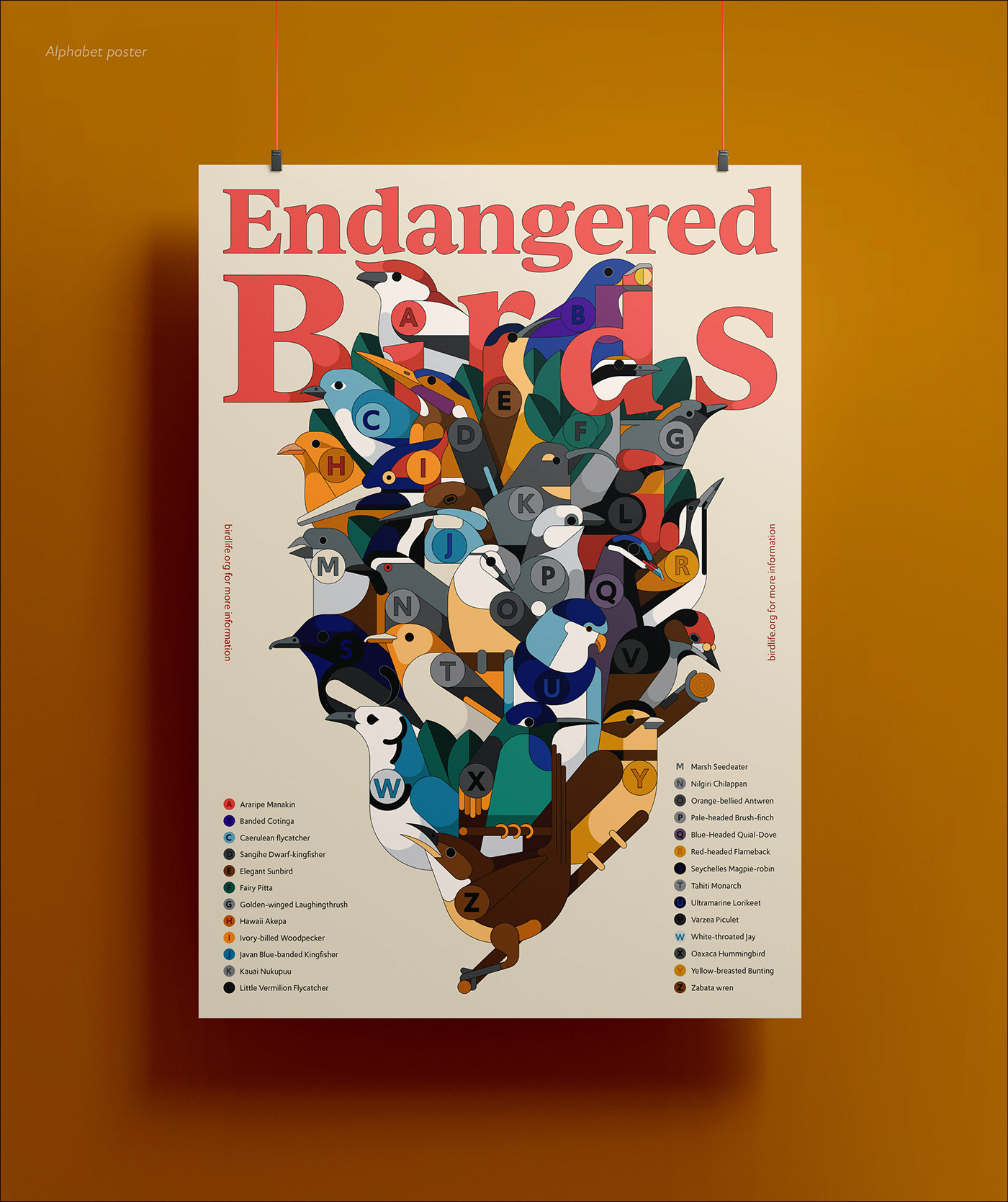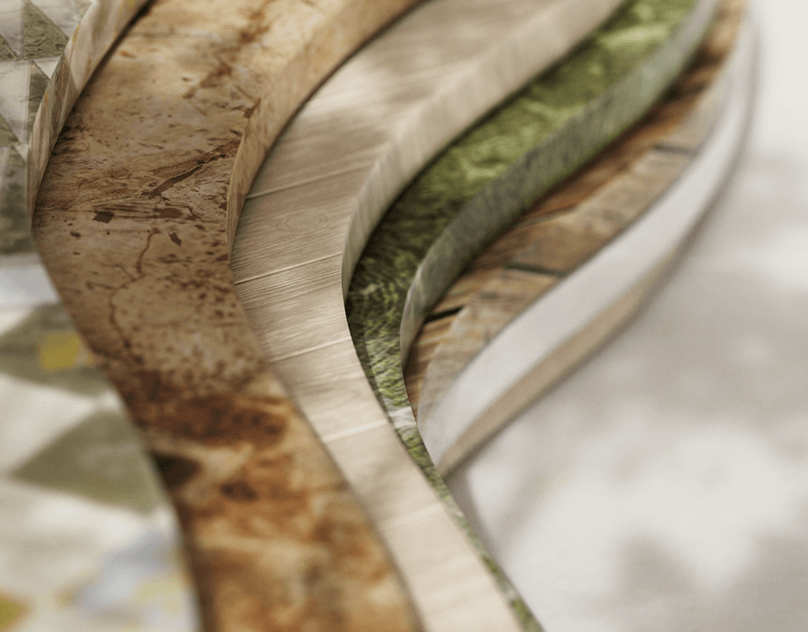
UNABRIDGED - SPEC TITLE SEQUENCE
A year and a half ago, I made the decision to dive into undertaking a new personal project. Given my fascination with "the art of the title" (not the website... though it's GREAT) it seemed to be a natural fit to take the initiative and create a title sequence. As I was kicking around the idea, I had mentioned the concept to one of my good friends who happened to be a theater director down in St. Louis at the time. He suggested a play he had directed from a play wright based out of L.A. - Sean Abley. Here's a quick synopsis of the play:
"Set in the not-so-distant future where language, libraries and books have been eradicated, Barker (a dispensary owner) sells education by the word to a junkie, (Cesar) against his better judgement knowing a wife and kid await him at home. Words have become currency and the competition has acquired an Unabridged Dictionary, siphoning Barker's business. An unknown society owns the literature, controls education and places a price tag on it: Cesar honors his "dealer" (Barker) by planning a heist of the Unabridged dictionary to bolster his business."
Around that time I had reached out to my friend DJ Freesmeier about joining efforts on a Spec Title Sequence for a non existent show based on this short play. Seeing as DJ is a professional photographer, he didn't have much experience with the Motion Design process. But, that didn't matter one bit. His eye for composition and storytelling through images was amazingly fun to work with throughout the ideation phase. We sat down and soon landed on a more fleshed out story to further the "world" of Unabridged as a show. Taking that time to plot out further show details allowed us to tie the visual story of our title sequence to a grounded object contextually.















THE ANIMATIC
With a solid direction to go in, DJ and I began mocking up some sketches to begin laying out an animatic. We latched on to a great idea DJ had early on of creating a camera obscura effect where we were able to see the outside world being projected into a space. From this we began to develop the idea that maybe this title sequence actually walked through different time lapsed scenes where we saw the gradual progression of this social irridaction of books. The outside projection would show bustling life of a 1950's Chicago Street dwindling down to reveal a scene of the aftermath of an uprising and culminating with the a pile of books igniting in the street.
We needed some kind of motivation for this camera obscura effect, so we began looking toward the main characters of Unabridged. We tied a back story to our dealer (Barker) of being a respected bookstore owner before a government initiative to collect and abolish all forms of literature took place. So, maybe we start the piece off with the outside world as seen through one of the bookstore windows when a sheet is put up, as if to hide the bookstore office from prying eyes. With that as the jumping off point, we filled out different scenarios to fill out the progression of the story.
- Close-up on a tobacco tin and piece of paper with a single word written on it to represent Cesar's "drug of choice" he would buy from Barker.
-Progression shot of books dissapearing within one of Barker's empty rooms above the bookstore with a column of smoke rising in the distance.
-A faceless man entering the front door of Barker's shop.
-Close-up of a children's book being picked up revealing a dust outline. (An ode to one of the original lines within the play).
-The streets of a south Chicago warehouse district with dismantled billboards jolting off the buildings.
-A street sign which represents how this "new world" communicates visually without using traditional, psychedelic inducing text.
-Progression shot of Cesar and his wife getting high on Barker's product.
-Showing a guarded Svalbard Seed Vault type entrance within a remote forest which conceals a secure literature repository inspired by the Beinecke Rare Book and Manuscript Library.

DJ's Initial Drawing

Storyboard
animatic
THE SHOOT
With the animatic as our road map, we began planning full production still shoots with a couple live action shots here and there. Because of our unlikely partnership between a motion designer and a photographer, the plan was to capture as much on screen content as possible in camera. I could then go back through and recreate each scene in 3D and projection map our photos onto that geometry. We had twenty some pages of notes we took on the exact measurements of a space, and the objects proximity to the camera and one another. Given the fact that we had nearly 5 different progression shots for several of the scenes, this became a pretty substantial task. Over the course of two weeks we hauled laundry baskets of books up to the third floor of an abandoned warehouse, spent considerable time in the MANY antique stores within our area, and hiked a chaise lounge up and down the narrow steps of DJ'S second floor studio more than too many times.
Of course, we were lucky enough to stumble into a well connected friend here in town, Alisabeth Von Presely, who had hooked us up with two ideal people for our main characters. Steven James stepped in as our rugged main character Barker and a talented local artist by the name of Jess High took the role of Cesar's Wife. We needed someone that gave off a SLIGHT Steam Punk vibe without being over the top and she came to the shoot prepared with wardrobe options that fit the bill perfectly. For our third character I turned to my long time friend and band mate Nathan Parsons to fill out our cast as Cesar.






With the shoot in the books, I began sorting through the massive heap of raw photos we'd taken. This all corresponded with the turn of 2018 and with that came a good amount of paid work. Throughout the first few months of 2019, I had little time to devote to the project so it stagnated a bit. However, after STILL having one personal project that's been open for almost 3 years now, I vowed not to allow that to happen to Unabridged. Eventually around the end of May I was able to dive back into the project. As I thumbed through the pile of photos, I got a solid SMACK in the face when I discovered something I simply couldn't believe I almost quite literally turned a blind eye to throughout all of this. THE. BOKEH. THE BOKEH!!!!! Gahhhhh, I couldn't believe I hadn't thought of it. Since I was planning on building geo in Cinema that matched the shots taken, I completely spaced on the fact that you need sharp pictures to project onto solid objects. It was time for a pivot.

Costume Mood board



PIVOT NUMBER ONE - REDSHIFT
With the entire technical approach thrown out the window, I began to explore if there might be ways I could just use the photos taken to still accomplish the desired affect. After much testing, I was able to create some viable options for certain reveals but the rest of the work was falling flat. I knew I'd have to essentially start from the ground up. Given that I was looking to get into Redshift at some point, I decided to bite the bullet and use this as my personal pioneering project into the render engine. I bought Redshift, and began a month long process of going through both GSG and HelloLuxx courses nights and weekends. Que sports training montage.
Early Exploration
Coming out of that month I felt fully prepared to dive in and begin building each scene from the ground up in Cinema. I decided to only focus my modeling efforts on key objects which would be the focus of a scene. 3dwarehouse became my go to source for free models. While they aren't ideal for many situations because they're built in Sketchup, every now and then you would find a great model that worked very well and needed very little TLC on the back end.
Within the first two shots I began to feel comfortable with my control over Redshift, however I still had much to learn on the optimization of materials and poly count as well as the organization of my scene files. The first renders I pushed out of RS were my first take of the underground book repository and I was just above 35 minutes per frame... and that simply wouldn't do.

Early Redshift Render
While I undoubtedly was learning a TON, I can't tell you how awfully I ended up managing this project's assets and render times. I had structured the piece so I had overlap within these progression shots, instead of finding a clever way to represent these changes within the Cinema render itself, I decided to take the "easy" route and render out multiple versions of a single scene. Effectively turning a 140 frame render into almost a 400 frame render and dissolving between the three in compositing. At an average of 14-17 minutes a frame, this turned into a long haul of juggling scene geo build outs, material and lighting set-ups and overnight/over weekend renders over the course of a few months. DO. NOT. DO. What I did...




Stills From The Initial cut
In the final months of 2019 I had been at it on my free time making slow but steady progress. By this point, I had become so burnt out on the project that I saw an end in sight and decided to sprint. Because of that, I was fully prepared to put the resulting piece out into the world as is, despite my MANY qualms with it. This first version felt more like a "MEHH" graphic section of a video game than it did a viable title sequence for a show. I decided to chalk it up as a hell of a workout for my creative and technical brain and move on.
With a piece I'd invested almost 400 hours into and many more learning the skills required to follow through, I decided to cap it off by reaching out to my friends at Overcoast Music to talk sound design. I would have LOVED to have them create an original score to accompany the piece, but I truly felt obligated to use this piece of music as I had paid nearly $500 dollars for it last December. I simply couldn't bring myself to cutting ties with it at this point in the process. Besides, the lyrical content of the song was still really working for me. Travis and his team were AMAZING to work with throughout the process. Historically speaking, I've always done my own sound design (and ENJOYED it), but in the spirit of the project, I wanted to broaden my horizons and work with some talented people that could elevate the piece properly. I gave them quite the task in creating sound design that was minimal yet full enough to accompany the airy, slightly off kilter music bed that had already been established. In the end I'm so thrilled with how the sound design turned out and a sincere thank you goes out to them for seeing this project through. I can't recommend Overcoast enough!!
3D Wireframe of Initial Cut
PHOTOGRAMMETRY + THE HOUDINI GURU
To back track a little bit - The last touches I put on the project before passing it on to Overcoast was to take the opportunity to learn the process of photogrammetry. I began many early tests by running through the whole process on a pair of tobacco tins I had found at one of the antique stores. I quickly learned that these kinds of hard surfaced objects simply don't hold up well to the automated processes of creating point clouds out of groups of pictures. I ended up creating the tobacco tins that made the final piece by hard surface modeling those elements and creating traditional diffuse and roughness maps within Photoshop, but my major victory came in the form of the hero object itself - the ever illusive Unabridged dictionary (they're harder to find than you'd think).
I won't dive in on the topic here as I simply followed Aaron Covretts approach he used on his amazing piece "The Harvest", but I will say, it was so much fun to jump in and discover just a tip of the potential this technology has. It really is amazing times we live in! To cap this piece off, one important shot was missing. The scene where we see dust particles outlining where the dictionary once sat, being blown off the table. This shot represents the disruption of a long standing social structure and while it may not play that way in the final piece, it logically made sense that I couldn't just stack up dust overlays in After Effects. I reached out to my friend Liam Clisham who has been doing AMAZING things in Houdini. He was able to quickly create a multi-million particle simulation of the dust blowing upward. In the end it was a very subtle effect, especially within the final version, but I can't thank him enough for lending his time and talents.
With the piece "done" and the final sound design coming in the door, I tossed and turned like I do many nights and decided to get up and watch the piece one more time. I couldn't quite put my finger on what I was feeling about it, but let's just say it was thoroughly dejecting looking at this piece that I had put so much work into and feel so empty about it. There was something about that viewing at 2:30 am that made me decide to push that extra bit further and try to salvage my personal pride in the piece.
First Full Cut
PIVOT NUMBER TWO- LET'S TRY SOMETHING DIFFERENT
The next day, which luckily was a Saturday, I sat down to take what I had built and treat it almost as if it were footage I had shot. I designed a few frames that were COMPLETELY off the wall from my original concept and ended up really gravitating toward a few of them. I began to reason with myself on this "crazy" new direction - "it's a personal project, why not?" "We've already put a lot of thought and meaning into the rest of the piece, why not just do something that looks interesting to ME?".
With that reasoning firmly sunk into my brain, I felt a re-ignited fire that hadn't been there on this project in a LONG time. There's something liberating in a situation like this when you give yourself permission just to create something you think looks good and isn't tied down to meaning on the most minute, in-communicable levels. That is in complete odds to what I believe makes the best storytelling, but dammit, it just felt good. Over the next two weeks I spent a heightened amount of time in between paid projects - during the day, at night, on the weekends - trying to follow that sliver of excitement I found for the project again.
BTS Progressions (3D WireFrames - Initial Cut - 2.5D WireFrames).
The most difficult pill to swallow throughout this crazy process was that we spent so much time on the shoots and only the photos of the characters made the final cut. With that said, while this is far from what I originally envisioned the piece becoming, I am proud of the effort that lead to the final outcome. It's accomplished everything I believe a personal project should; test your creative process, break your creative process, learn new skills, progress existing ones and move FAR outside of your comfort zone.
When I look back on this piece I will think of the collaboration and the many people that brought their own personal touch to the piece. On the surface, this may take the form of a personal project, but it really was a collaborative effort which would better be described as a continuously evolving passion project. Thank you to everyone involved and I hope that one day you're able to take a group of talented artists efforts and throw it into a visual blender to see what happens. It's excruciating...ly satisfying.









